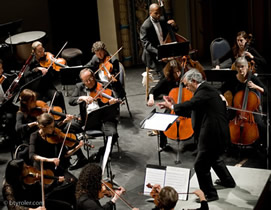The large audience of music lovers in Christ United Methodist Church found the solid and spirited performances of the Trio Solisti piano trio well worth the delayed start of this edition of Music for a Great Space. The ensemble consists of violinist Maria Bachmann, cellist Alexis Pia Gerlach, and pianist Jon Klibonoff. Getting musicians who are traveling separately to arrive together can get complicated. Fog forced pianist Klibonoff to land in Richmond, Virginia and rent a car. He arrived at the venue barely an hour before the performance, which was itself delayed by the needed warm up. The scheduled Piano Trio No. 2 in B minor, Op. 76, by Joaquin Turnia, was dropped, and the sequence of works was modified.
The great master work, Piano Trio in B-flat, Op. 97 (Archduke) by Ludwig van Beethoven (1770-1827) became the opening work. The work is one of many dedicated to the Archduke Rudolph who was the younger brother of the Austrian emperor and who was the student, patron, and friend of the composer for most of his life. The “Hammerklavier” Sonata, Op. 106 and Missa Solemnis are among the works dedicated to the Archduke. This piano trio dates from Beethoven’s “middle period” along with such works as the “Emperor” Piano Concerto No. 5, and the Seventh and Eight Symphonies. It shares with these works the composer’s self-assurance along with melodic breadth and richness. The opening movement is spacious with an air of great nobility and moving expressivity. It is followed by a disarming scherzo that has a rhythm suggestive of a Ländler. The third movement is a set of five related variations based upon a serene hymn-like theme. The concluding movement is a rondo which has some prominent display for the piano before a long coda leads to a noble closing.
Trio Solisti gave a contemplative and spacious interpretation of the first movement. Christ Church’s acoustics can be muddy for chamber music involving the piano. The piano’s lid was set with the shortest stick and Klibonoff was especially skilled at reining in his dynamics. Both string players had excellent intonation, marvelous phrasing, and refined tone. The trio’s performance was richly satisfying in its cumulative effect.
Two selections from the Four Seasons of Buenos Aires by Ástor Piazzolla (1921-1992), which replaced a Turina trio, came next. The original work was scored for Piazzolla’s Argentine tango quintet which included the composer’s instrument. the bandoneón, piano, violin, electric guitar, and double bass. A cellist in the composer’s octet, José Bragato, made a bare-bones arrangement for piano trio. Bachmann further enhanced this to try to capture the percussive effects the musicians would have improvised in performance. “Primavera Portena” (Spring) was followed by “Otono Porteno.” Trio Solisti brought considerable rhythmic verve and sense of flair to their interpretation. Bachmann made an interesting rasping sound by bowing the strings between the bridge and the tailpiece of her violin. Gerlach slapped the sides and top of her cello to make some of the percussive effects. Their performance was enthusiastically received by the audience.
The concert ended with the rarely performed and unjustly neglected Piano Trio in G minor, Op. 3 by Ernest Chausson (1885-1899). The composer’s creative period is often divided into three parts. Chausson studied with Jules Massenet and his first period is dominated by his composition teacher’s influence and features elegant, flowing melodies. Beginning in 1886, his second period’s works are much more dramatic, reflecting Chausson’s wider circle. His final period dates from his father’s death in 1894 and reflects his reading of the French and Russian symbolist poets and Russian Literature. Chausson had been working on a string quartet when he was tragically killed when he bicycled into a brick wall. His compositions sometimes hint at the influence of Frank and Wagner and some think Chausson’s idiom bridges the gap between the ripe Romanticism of Massenet and Frank and Debussy’s so-called Impressionism.
The Opus 3 trio is an early work with engaging melodies, and interesting and skilled writing for the instruments. It has thick textures, dark harmonic progressions, and sudden dynamic changes. The first, third, and fourth movements make extensive use of the cyclic treatment of themes characteristic of César Frank’s school. The first movement often evokes memories of Frank’s style but somehow applied with Chausson’s individuality. The lively second movement often reminded me of a theme from the composer’s own Symphony in B-flat. Despite suggestions of other composer’s influence, there is far more than enough of Chausson’s originality to whet the appetite for more frequent performances of the trio. Trio Solisti made the strongest possible case for the trio and they ought to consider it for their next future recording. Bravo!











